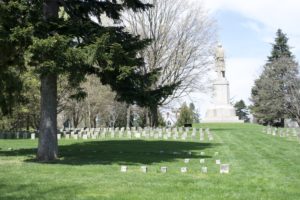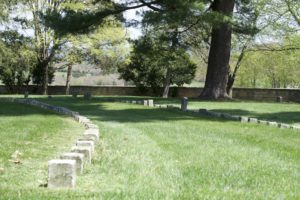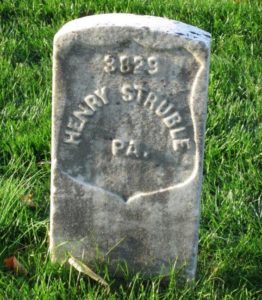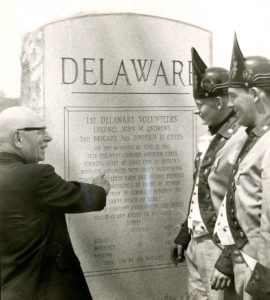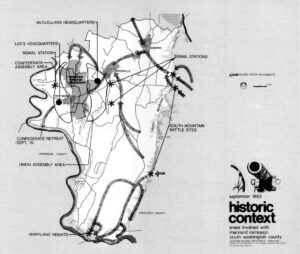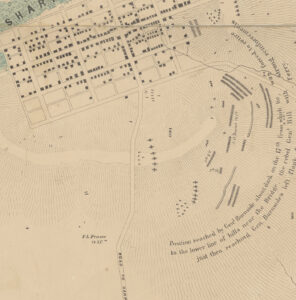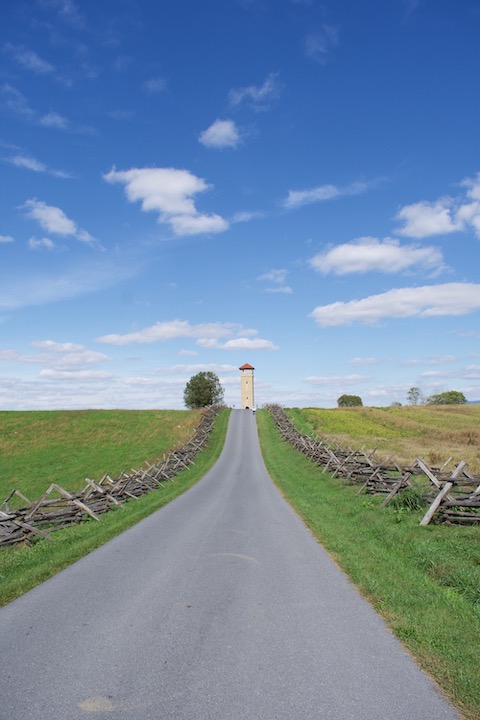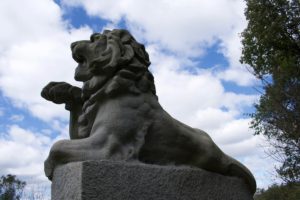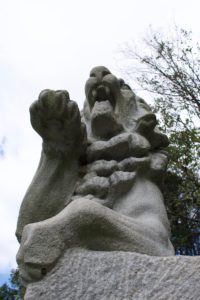Corporal Farmer gets a new stone
16 April 2024
This is the first time I’ve seen this in many years visiting Antietam National Cemetery: an obvious replacement headstone. And not just because of wear and tear. An Ohioan in a row of Connecticut soldiers.
There’s a great story here, I’m sure, but I only know part of it.
William Whitney Farmer, 34, of Wakeman, Ohio enlisted as a Corporal in Company D, 8th Ohio Infantry in June 1861, and was killed by artillery at Antietam on 16 September 1862. He was mis-identified as being in the 8th Connecticut Infantry when he was removed from his resting place on the battlefield and re-buried in the new Antietam National Cemetery in 1867.
Here’s the headstone that’s been over his grave since then:
On my visit last Friday, though, this brand new, fresh cut stone jumped out at me:
I hope a reader will let us know how this came about. You won’t be surprised to hear there are many, perhaps hundreds of headstones in the Cemetery with errors large and small, and I would never have expected the Park Service or the VA to replace any of them.
And yet … here we are.
Notes
The photos above of Farmer’s new headstone are by the author, taken at the Antietam National Cemetery on Friday 12 April 2024.
His original headstone photo is from contributor Birdman on Farmer’s online memorial at Find-a-grave.
The page image here is from the 1890 version of the History of the Antietam National Cemetery, including a descriptive list of all the loyal soldiers buried therein …, published by George Hess, late Private, 28th Pennsylvania Infantry; online from the Library of Congress. His work is a virtual copy of the History published by the Cemetery Board of Trustees in 1867, except that Hess noted the headstone numbers, which I find more useful than the section/lot/grave numbers in the original volume.
Sgt Charles Broomhall at Antietam
14 April 2024
Almost exactly 20 years ago Carolyn Ivanoff shared with me (and AotW) her research about and transcription of the wartime diary of Charles D. M. Broomhall, Sergeant in the 124th Pennsylvania Infantry, describing his experience on the Maryland Campaign.
On my visit to the battlefield last Friday morning I saw this wayside for the first time. Maybe I just never stopped at that spot before.
I was stunned to see the heading quote from Sergeant Broomhall, from Carolyn’s work in the diary. That “fluttering” reference comes from a few lines earlier in his narrative:
At the commencement of the battle at day dawn [on 17 September 1862], our boys had been listening to the stray shots on the edge of the 1st named woods called the East Woods, the rebels had come through the corn and deployed pickets on the edge of the East Woods. Our pickets were deployed in the edge of this woods, consequently, at daylight the two picket lines found themselves face to face and that caused the suddenness of the onset. Our brigade was about 1/4 of a mile to the right and rear, and our regiment was brought up to near the clear sod field first spoken of while shot and shell went fluttering over our heads like partridges for sound.
Thanks again, Carolyn!
Spring Symposium weekend at Sharpsburg
27 April 2023
I made my semi-annual pilgrimage to Sharpsburg last week, focused on the Antietam Institute‘s Spring Symposium. For much more about the 2023 Symposium itself, look for Facebook and other social media posts from the Institute and some of my fellow attendees.
I had some time while in the area, also, to get to the Antietam National Cemetery to find one of my guys, and to roam the Antietam battlefield to visit a few cannon.
National Cemetery serendipity
29 April 2022
As I’ve done on my last several trips to the battlefield, I stopped to visit a few stones in Antietam National Cemetery this past week. Starting at the “back” – the south wall of the cemetery – I noticed particularly the rows of markers for the many unknown soldier buried there …
Not in Antietam National Cemetery
4 February 2022
There are several stones in the Antietam National Cemetery for men who were actually buried elsewhere.
Readers occasionally ask about this, and I can never find them when I want them, hence this list. It will evolve as I learn more.
| Rank | Name | Unit | Death | Actual burial place |
| Pvt | Bridgeman J. Hollister | 16th CT Inf | 25 Sept 1862 | Wassuc Cemetery, Glastonbury, CT |
| Pvt | Oliver Cromwell Case | 8th CT Inf | 17 Sept 1862 | Simsbury Cemetery, Simsbury, CT |
| Pvt | Henry Struble | 8th PA Reserves | 2 June 1926 | St. John’s Reformed Cemetery, Greenburg, PA |
| Pvt | William Ayers Salisbury | 34th NY Inf | 17 Sept 1862 | Norway Rural Cemetery, Norway, NY |
| Pvt | William H Lewis | 34th NY Inf | 16 Jan 1916 | Oak Hill Cemetery, Herkimer, NY |
__________________
The photo of Henry Struble’s marker is from his Find-a-grave memorial, and was contributed by user John in Maryland.
Pre- and post- Conference snaps
24 October 2021
I had a tremendous time last weekend on and near the Antietam battlefield with my fellow Antietam Institute members at our first annual Fall Conference. Here we are at the New York State monument on Sunday morning.
For online coverage of that successful event, see the Institute’s Facebook page and those of other attendees.
I arrived in Sharpsburg on Thursday afternoon and had some time in the National Cemetery before dark. The sky was that particularly vivid shade of blue typical of the battlefield.
While there, I “collected” some Pennsylvania and Indiana gravestones to look into later. This one is for Private Erasmus Davenport of Company G, 27th Indiana Infantry.
Born in Brown County, Indiana on 3 September 1843, he enlisted at age 18 in September 1861. He died, probably of disease, in Frederick, Maryland less than three months later on New Year’s Day 1862. He was reinterred in the new National Cemetery about 1867.
I didn’t take many pictures during the Conference itself, but did grab this one on Saturday afternoon as the rain began.
It’s one of a pair of guns representing the position of Captain Hugh Garden’s Palmetto Artillery and is on the high ground of Cemetery Hill behind the National Cemetery. That battery was equipped with 2 12-pounder howitzers and 2 6-pounder guns. Neither type was rifled.
As some of the folks on the walk with me noted, it’s an interesting example. It’s apparently the tube of a Model 1841 6-pounder, but has been rifled. Perhaps in the James pattern? As I think of it now, a photo of the muzzle end would have been helpful.
After the final Conference hike on Sunday afternoon I fortified myself with a late lunch at the Battleview Market and returned to the Park for a last-chance visit before returning south for the winter. First stop, the West Woods and Philadelphia Brigade Park.
There are a few relatively recent monuments at Antietam – notably those for Texans (1964), Georgians (1961), and to the 11th Mississippi Infantry (2012, on then-private land) – planted during the Civil War Centennial and after. While I know the others well, this is one I hadn’t really noticed before.
It’s one of 3 placed by the state Centennial Commission in 1962 and 1964. The other two, to the First and Second Regiments, are in or near the Bloody Lane. Here’s a particularly interesting picture taken at the 1962 dedication of the one to the First Delaware.
I’d be interested to hear more about those uniforms!
Nearby, at the end of the road in the Philadelphia Brigade Park is an interpretive panel which I hope the Park can soon update or replace. It’s a little out of date. Here’s a detail from it:
It shows a house and barn on the battlefield across from the Cornfield, noting “This farm was not here in 1862.”
Known in modern times as the Wilson Farm, that land was part of the David R. Miller Farm at the time of the battle and there were no buildings on it then. In 2015 the Civil War (now Battlefield) Trust bought the 44 acre tract from the Wilson family. Later SHAF and the Trust had the buildings taken down and restored the landscape to its 1862 appearance. All of it is now Park property.
Finally, on the way out I stopped to spend a moment at my favorite battlefield farmstead: the Joseph Poffenberger place at the northern edge of the Park. Here’s it is just beyond a War Department marker locating part of the First Army Corps on the evening of 16 September 1862.
Until next time, so long, Antietam.
__________________
Notes
Click on any photo to see a larger version.
The itinerary of the 2021 Fall Conference is on the Institute’s website.
The group photograph of the Conference attendees above is by Randy Short for the Institute. The snapshots are my own.
Private Davenport’s details from his service record via fold3 and from family genealogists.
More about the representative cannons on the Antietam Battlefield in a WMIA/ Park brochure (still current and accurate?).
Thanks to Steve A. Hawks for his excellent Silent Sentinels monument database, linked here.
FYI. There has been a moratorium on new monuments on Park property at Antietam since 1991. Here’s a little background on that from some US Senate testimony in 2005 concerning a proposed new monument to New Hampshire troops (which was not placed):
A moratorium has been in place since 1991 at the [Antietam] battlefield, which precludes the construction of new monuments or memorials. The need for a moratorium was identified as necessary during the development of the General Management Plan (GMP). The GMP is a long-term planning document that provides NPS managers with guidelines and objectives in the preservation of these historic grounds. The study of the battlefield, which culminated in this GMP, was undertaken with substantial input from the public and civil war historians nationwide. The findings concluded that the continued addition of memorials would result in an unacceptable permanent alteration of the historic landscape. The NPS conducts an active year-round program to educate visitors about the Battle of Antietam and to pay tribute to the valor and sacrifice of all those who shared in the pivotal history of this battle …
That 1962 picture is from the Delaware Economic Development Photograph Collection, Delaware State Archives.
More photos of the old Wilson Farm are online from HistoryNet in a piece by Tom Clemens from 2017.
For fun, check out the Cultural Landscape of the J. Poffenberger farm today.
the visible landscape, historic context
29 January 2021
In April 1988 the US Park Service produced a report about the Antietam National Battlefield and surroundings called analysis of the visible landscape [pdf]. Its stated purpose:
Recently, residents and state and local administrators have become concerned that the rural character and lifestyle of south Washington County, including Antietam National Battlefield, are being eroded by poorly planned suburban development. The National Park Service shares this concern because of the potential threat to the agricultural setting which is so important to the historic scene at Antietam. During the summer of 1987, the Maryland Department of State Planning contacted Antietam Superintendent Richard Rambur requesting National Park Service assistance with the South County Study for land use planning. Specifically, the state sought information on which areas contribute to the scenic quality of the battlefield. This report has been prepared in response to that request.
It’s an excellent work which, along with local preservation activism, contributed to increased zoning and easement protections for the land on and near the battlefield. You can easily see the results when you visit the Park today.
I think this map, from that report, is the nicest overview of the geography and military activity of the Maryland Campaign I’ve ever seen, which leads me to share it with you, both of my readers. It was probably drawn by John Ochsner, Landscape Architect at the Denver Service Center, US Park Service.
The dead of Antietam 158 years later
9 September 2020
On the occasion of the battle anniversary this month I’ve taken stock of the AotW database. There may be another lifetime’s work to do in other areas of the Campaign, but I now have a reasonably complete list of the troops who were killed and mortally wounded at Sharpsburg. The first of its kind anywhere, as far as I know. Pretty cool!
I’ve created a couple of new reports on the subject which you can download at the end of this post.
When I count the individuals who were killed outright or were mortally wounded and died on 16, 17, or 18 September 1862 I get 1,653 Confederates (the Official Records say 1,550 were killed) and 2,205 Federals (OR has 2,100).
I’ve also pulled the names of the soldiers who died of their Sharpsburg wounds in the days and weeks afterward. These make an additional 772 Confederates and 980 Federals.
So if you suspected the official numbers were a little low, you were right. As a caution, let me remind both my readers that the records are sometimes awful and occasionally missing altogether, and besides, I’ve certainly not seen every source there is to see. I’m sure I’ll find more names to add.
Also, I need to look at it some more, but there may be enough in my collection to name most of those 5,800+ burials on the newly-identified S.G. Elliott map. Just don’t ask me to guess which of those little marks are which person. I haven’t looked at any others on the map yet [update: see my annotated exhibit on the Elliot map], but the man listed in the map portion above as F.L. Fraser is E. L. Fraser, Private of Company I, 12th South Carolina. Later records of his field burial correlate well with the 1864 Elliott map.
Ok, so just in time for the anniversary, here are 2 versions each of two reports listing the killed of Antietam. As always, if you can add names or improve the information please let me know.
Men Killed in the Battle of Antietam at Sharpsburg, Maryland 16-18 September 1862
Sorted by state | Sorted by rank [3834 names, 1.0 MB pdf]
Men Who Later Died of Wounds from the Battle of Antietam at Sharpsburg
Sorted by state | Sorted by rank [1736 names, 500 KB pdf]
________________
These new lists and the ongoing Dead of the Campaign list are also hosted, and will be updated in the future, under Antietam 150: The Dead of the Maryland Campaign elsewhere on this blog.
The Antietam observation tower and the birth of the Park
1 December 2018
My project on the visual history of the Antietam National Battlefield continues, focused today on one of the most iconic features on the field – the Observation Tower. Since it was built in 1896 the tower has been a central memorial and educational feature of the National Battlefield, and it has always been a popular destinations for visitors.
So how did it come to be, and how has its story evolved in the last 122 years?
It starts with the origins of the battlefield park itself.
The Wounded Lion
21 October 2018
On our most recent trip to the battlefield we walked part of the West Woods Trail, mostly to see the most unique monument on the battlefield – that for the 15th Massachusetts Volunteer Infantry. One of my favorites.
There’s been a lot of interest in this lion online lately, at least in the places I go, but nothing about its maker.I was inspired to look into the sculptor by the “signature block” he left on the slab under the lion’s left front paw.






